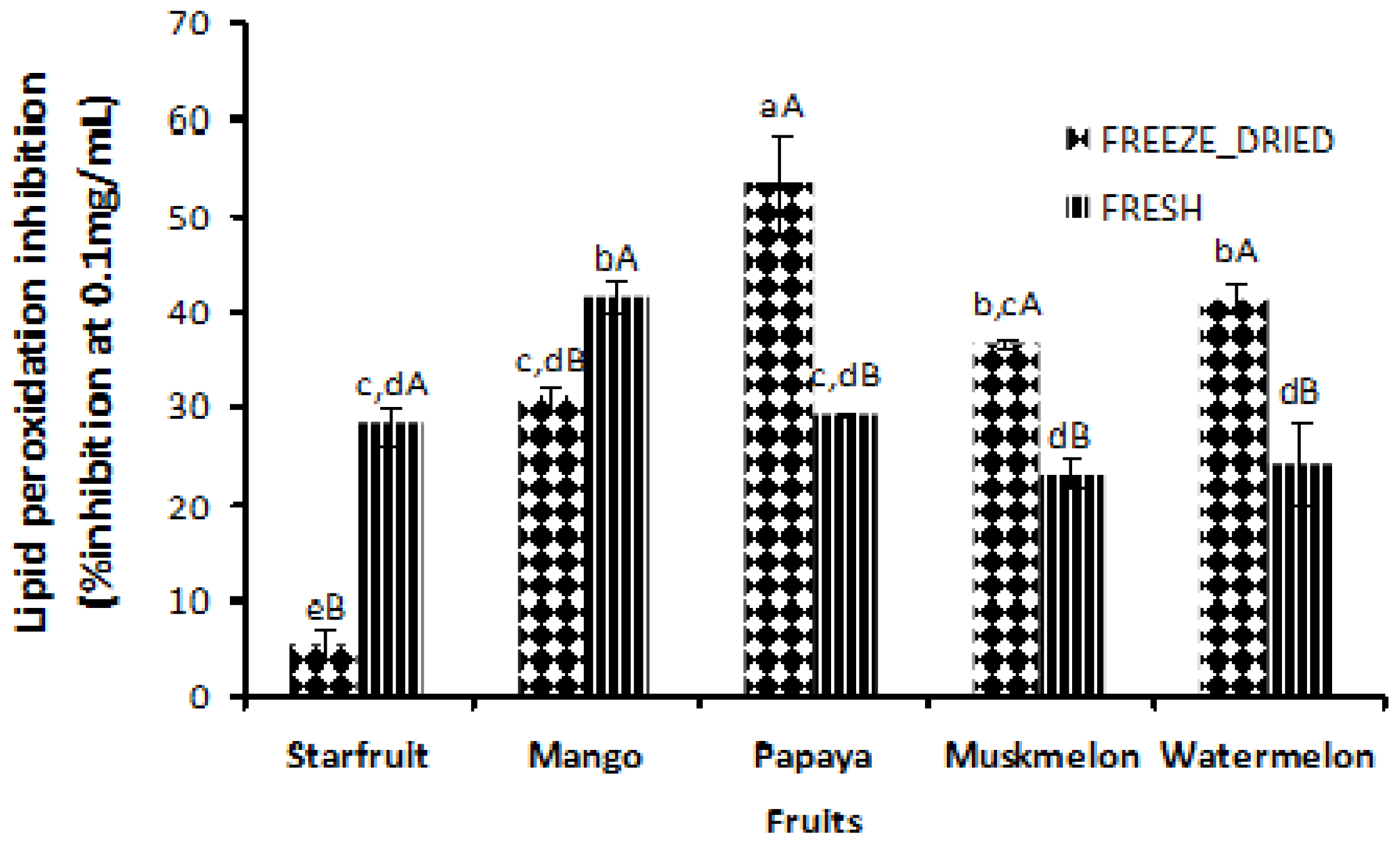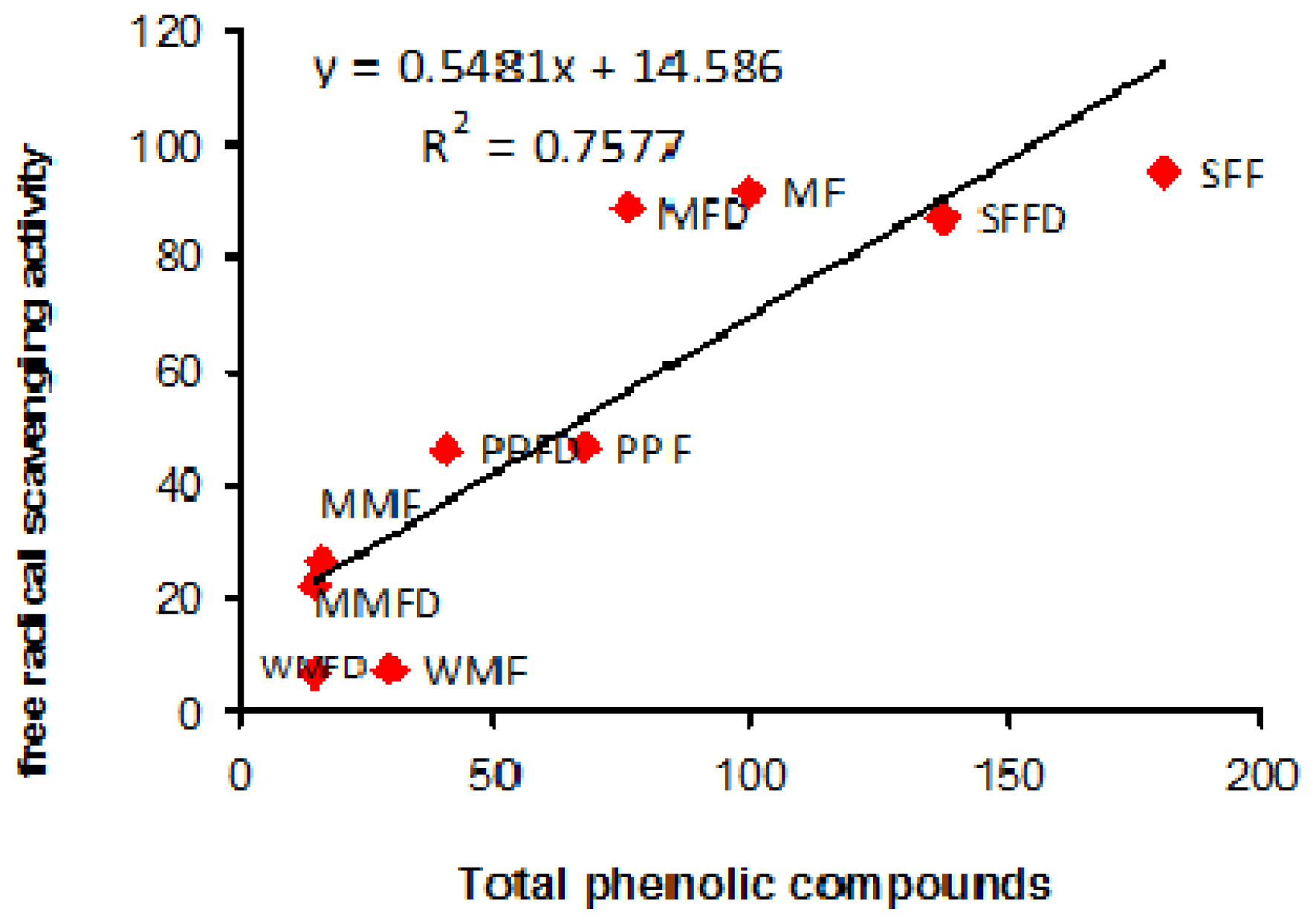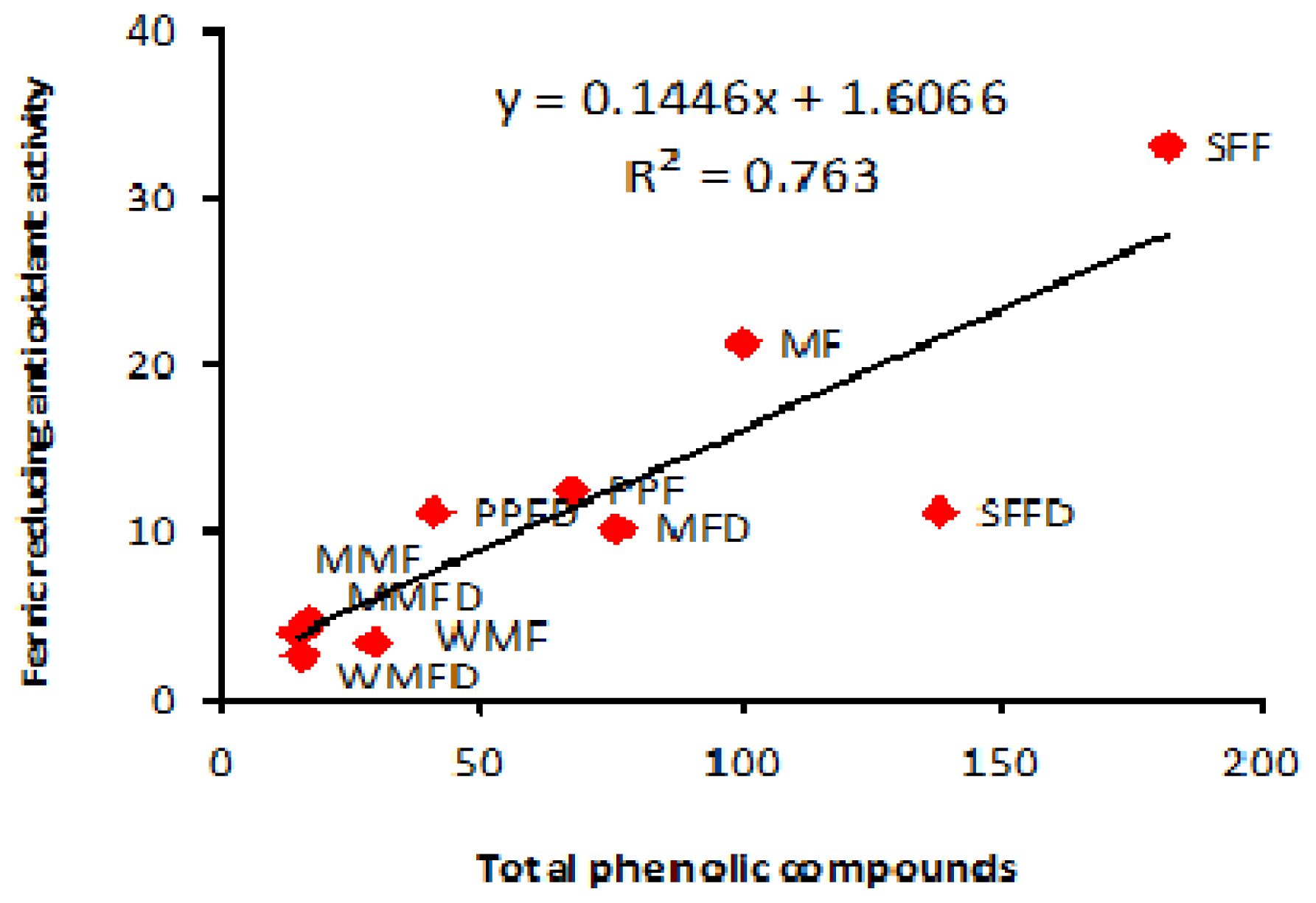Effect of Freeze-Drying on the Antioxidant Compounds and Antioxidant Activity of Selected Tropical Fruits
Abstract
:1. Introduction
2. Results and Discussion
2.1. Moisture Content
2.2. Total Phenolic Compounds (TPC)
2.3. Ascorbic Acid Content
2.4. β-Carotene Content
2.5. DPPH (2,2-diphenyl-1-picrylhydrazyl) Radical Scavenging Activity
2.6. Ferric Reducing Antioxidant Activity
2.7. Antioxidant Activity in Terms of Lipid Peroxidation Inhibition by Conjugated Diene Assay
2.8. Correlation between Antioxidant Compounds Antioxidant Activity of Fruits
3. Experimental Section
3.1. Chemicals
3.2. Preparation of Fruit Extracts
3.3. Determination of Moisture Content
3.4. Determination of Total Phenolic Compounds (TPC)
3.5. Determination of Ascorbic Acid
3.6. Determination of β-Carotene
3.7. Determination of DPPH Free Radical Scavenging Activity
3.8. Determination of Ferric-Reducing Antioxidant Activity
3.9. Determination of Antioxidant Activity by Inhibition of Linoleic Acid Peroxidation
3.10. Statistical Analysis
4. Conclusions
Acknowledgments
References
- Ames, BM; Shigena, MK; Hagen, TM. Oxidants, antioxidants and the degenerative diseases of aging. Proc. Natl. Acad. Sci. USA 1993, 90, 7915–7922. [Google Scholar]
- Duthie, SJ; Ma, A; Ross, MA; Collins, AR. Antioxidant supplementation decreases oxidative DNA damage in human lymphocytes. Cancer Res 1996, 56, 1291–1295. [Google Scholar]
- Vivekananthan, DP; Penn, MS; Hsu, A; Topol, EJ. Use of antioxidant vitamins for the prevention of cardiovascular disease: Meta-analysis of randomised trials. Lancet 2003, 361, 2017–2023. [Google Scholar]
- Heliovaara, M; Knekt, P; Aho, K; Aaran, RK; Alfthan, G; Aromaa, A. Serum antioxidants and risk of rheumatoid arthritis. Ann. Rheum. Dis 1994, 53, 51–53. [Google Scholar]
- Klerk, M; Veer, P; van’t Kok, FJFJ. Fruits and Vegetables in Chronic Disease Prevention; LUW: Wageningen, The Netherlands, 1998; p. 86. [Google Scholar]
- Lim, YY; Lim, TT; Tee, JJ. Antioxidant properties of several tropical fruits: A comparative study. Food Chem 2007, 103, 1003–1008. [Google Scholar]
- Wong, SP; Leong, LP; Koh, JHW. Antioxidant activities of aqueous extracts of selected plants. Food Chem 2006, 99, 775–783. [Google Scholar]
- Pérez-Gregorio, MR; Regueiro, J; González-Barreiro, C; Rial-Otero, R; Simal-Gándara, J. Changes in antioxidant flavonoids during freeze-drying of red anions and subsequent storage. Food Control 2011, 22, 1108–1113. [Google Scholar]
- Robles-Sánchez, RM; Rojas-Graüb, MA; Odriozola-Serranob, I; González-Aguilara, GA; Martín-Bellosob, O. Effect of minimal processing on bioactive compounds and antioxidant activity of fresh-cut “Kent” mango (Mangifera indica L.). Postharvest Biol. Technol 2009, 51, 384–390. [Google Scholar]
- Patthamakanokporn, O; Prapasri, P; Anadi, N; Prapaisri, PS. Changes of antioxidant activity and total phenolic compounds during storage of selected fruits. J. Food Compos. Anal 2008, 21, 241–248. [Google Scholar]
- Pérez-Gregorio, MR; Garcia-Falcon, MS; Simal-Gandara, J. Flavonoids changes in fresh-cut onions during storage in different packaging systems. Food Chem 2011, 124, 652–658. [Google Scholar]
- Pérez-Gregorio, MR; Regueiro, J; Alonso-González, E; Pastrana-Castro, LM; Simal-Gándara, J. Influence of alcoholic fermentation process on antioxidant activity and phenolic levels from mulberries (Morus nigra L.). LWT-Food Sci. Technol 2011, 44, 1793–1801. [Google Scholar]
- Rodrigues, AS; Pérez-Gregorio, MR; García-Falcón, MS; Simal-Gándara, J. Effect of curing and cooking on flavonols and anthocyanins in traditional varieties of onion bulbs. Food Res Int 2009, 42, 1331–1336. [Google Scholar]
- Marques, LG; Prado, MM; Freire, JT. Rehydration characteristics of freeze-dried tropical fruits. J. Food Sci. Technol 2009, 42, 1232–1237. [Google Scholar]
- Marques, LG; Silveira, AM; Freire, JT. Freeze-drying characteristics of tropical fruits. Drying Technol 2006, 24, 457–463. [Google Scholar]
- Chang, CH; Lin, HY; Chang, CY; Liu, YC. Comparisons on the antioxidant properties of fresh, freeze-dried and hot-air-dried tomatoes. J. Food Eng 2006, 77, 478–485. [Google Scholar]
- Murcia, MA; Lopez-Ayerra, B; Martinez-Tome, M; Vera, AM; Garcia-Carmon, F. Evolution of ascorbic acid and the peroxidase during industrial processing of broccoli. J. Sci. Food Agric 2000, 80, 1882–1886. [Google Scholar]
- Luximon-Ramma, A; Bahorun, T; Crozier, A. Antioxidant actions and phenolic and vitamin C contents of common Maurition exotic fruits. J. Sci. Food Agric 2003, 83, 496–502. [Google Scholar]
- Wu, X; Beecher, GR; Holden, JM; Haytowitz, DM; Gebhardt, SE; Prior, RL. Lipophilic and hydrophilic antioxidant capacities of common foods in the United States. J. Agric. Food Chem 2004, 52, 4026–4037. [Google Scholar]
- Brat, P; George, S; Bellamy, A; Chaffaut, LD; Scalbert, A; Mennen, L. Daily polyphenol intake in France from fruit and vegetables. J. Nutr 2006, 136, 2368–2373. [Google Scholar]
- Moure, A; Franco, D; Sineiro, J; Domínguez, H; Núñez, MJ; Lema, JM. Evaluation of extracts from Gevuina avellana hulls as antioxidants. J. Agric. Food Chem 2000, 48, 3890–3897. [Google Scholar]
- Boudries, H; Kefalas, P; Hornero-Mendez, D. Carotenoid composition of Algerian date varieties (Phonenix datylifera) at different edible maturity stages. Food Chem 2007, 101, 1372–1377. [Google Scholar]
- Charoensiri, R; Kongkachuichai, R; Suknicom, S; Sungpug, P. Beta carotene, lycopene and alpha tocopherol contents of selected Thai fruits. Food Chem 2009, 113, 202–207. [Google Scholar]
- Wall, MM. Ascorbic acid, vitamin A and mineral composition of banana (Musa sp.) and papaya (Carica papaya) cultivars grown in Hawaii. J. Food Compos. Anal 2006, 14, 434–445. [Google Scholar]
- Ashie, INA; Simpson, BK. Application of high hydrostatic pressure to control enzyme related fresh seafood texture deterioration. Food Res. Int 1996, 29, 569–575. [Google Scholar]
- Aherne, SA; Ŏ’Brien, NM. Dietary flavonols: Chemistry, food contents and metabolism. Nutrition 2002, 18, 75–81. [Google Scholar]
- Amarowicz, R; Carle, R; Dongowski, G; Durazzo, A; Galensa, R; Kammerer, D; Malani, G; Piskula, M. Influence of postharvest processing and storage on the content of phenolic acids and flavonoids in foods. Mol. Nutr. Food Res 2009, 53, S151–S183. [Google Scholar]
- Leong, LP; Shui, G. An investigation of antioxidant capacity of fruits in Singapore markets. Food Chem 2002, 76, 69–75. [Google Scholar]
- Franke, AA; Custer, LJ; Arakaki, C; Murphy, SP. Vitamin C and flavonoid levels of fruits and vegetables consumed in Hawaii. J. Food Compos. Anal 2004, 17, 1–35. [Google Scholar]
- Hernandez, Y; Gloria, LM; Gonzalez, M. Determination of vitamin C in tropicals fruits: A comparative evaluation of methods. Food Chem 2006, 96, 654–664. [Google Scholar]
- Hawlader, MNA; Perera, CO; Tian, M; Yeo, KL. Drying of guava and papaya: Impact of different drying methods. Drying Technol 2006, 24, 77–87. [Google Scholar]
- Jayaraman, KS; Ramanaja, MN; Dhakne, YS; Vijayaraghavan, PK. Enzymatic browning in some varieties as related to PPO activity and other endogenous factors. J. Food Sci. Technol 1982, 19, 181–185. [Google Scholar]
- Tee, ES; Lim, CL. Carotenoid composition and content of Malaysian vegetables and fruits by the AOAC and HPLC methods. Food Chem 1991, 41, 309–339. [Google Scholar]
- Veda, S; Platel, K; Srinivasan, K. Varietal Differences in the Bioaccessibility of β-carotene from Mango (Mangifera indica) and Papaya (Carica papaya) Fruits. J. Agric. Food Chem 2007, 55, 7931–7935. [Google Scholar]
- Mangels, AR; Holden, JM; Beecher, GR; Forman, MR; Lanza, E. Carotenoid content of fruits and vegetables: An evaluation of analytic data. J. Am. Diet. Assoc 1993, 93, 284–296. [Google Scholar]
- Setiawan, B; Sulaeman, A; Giraud, DW; Driskell, JA. Carotenoid content of selected Indonesian fruits. J. Food Compos. Anal 2001, 14, 169–196. [Google Scholar]
- Vamos-Vigyazo, L. Polyphenol oxidase and peroxidase in fruits and vegetables. Crit. Rev. Food Sci. Nutr 1981, 15, 49–127. [Google Scholar]
- Hunter, KJ; Fletcher, JM. The antioxidant activity and composition of fresh, frozen, jarred and canned vegetables. Innov. Food Sci. Emerg. Technol 2002, 3, 399–406. [Google Scholar]
- Tengku-Adnan, TA; Augustin, MA; Mohd-Ghazali, H. Polyphenoloxidase from Starfruit (Averrhoa carambola L.). Pertanika 1986, 9, 219–224. [Google Scholar]
- Flurkey, WH; Jen, JJ. Peroxidase and PPO activites in developing peaches. J. Food Sci 1978, 43, 1826–1828. [Google Scholar]
- Augustin, MA; Mohd-Ghazali, H; Hashim, H. Polyphenoloxidase from guava (Psidium guajava L.). J. Sci. Food Agric 1985, 36, 1259–1265. [Google Scholar]
- Park, YK; Sato, HH; Almeida, TD; Moretti, RH. Polyphenol oxidase of mango (Mangifera indica, var. Haden). J. Food Sci 1980, 45, 1619–1621. [Google Scholar]
- Lee, YL; Yen, MT; Mau, JL. Antioxidant properties of various extracts from Hypsizigus marmoreus. Food Chem 2008, 104, 1–9. [Google Scholar]
- Lee, YL; Yang, JH; Mau, JL. Antioxidant properties of water extracts from Monascus fermented soybeans. Food Chem 2007, 106, 1128–1137. [Google Scholar]
- Miliauskas, G; Venskutonis, PR; van-Beek, TA. Screening of radical scavenging activity of some medicinal and aromatic plant extracts. Food Chem 2004, 85, 231–237. [Google Scholar]
- Kosar, M; Bozan, B; Temelli, F; Baser, KHC. Antioxidant activity and phenolic composition of sumac (Rhus coriaria L.) extracts. Food Chem 2007, 103, 952–959. [Google Scholar]
- Association of Official Analytical Chemists (AOAC), Official Methods of Analysis, 15th ed; Association of Official Analytical Chemists Inc.: Arlington, VA, USA, 1990.
- Singleton, VL; Orthofer, R; Lamuela-Ravento’s, RM. Analysis of total phenols and other oxidation substrates and antioxidants by means of Folin-Ciocalteu reagent. Methods Enzymol 1999, 299, 152–178. [Google Scholar]
- Wimalasiri, P; Wills, RBH. Simultaneous analysis of ascorbic acid and dehydroascorbic acid in fruit and vegetables by HPLC. J. Chromatogr 1983, 15, 418–421. [Google Scholar]
- Brand-Williams, W; Cuvelier, ME; Berset, C. Use of a free radical method to evaluate antioxidant activity. LWT-Food Sci. Technol 1995, 28, 25–30. [Google Scholar]
- Benzie, IFF; Strain, JJ. Ferric reducing antioxidant power assay: Direct measure of total antioxidant activity of biological fluids and modified version for simultaneous measurement of total antioxidant power and ascorbic acid concentration. Methods Enzymol 1999, 299, 15–27. [Google Scholar]
- Lingnert, H; Vallentin, K; Eriksson, CE. Measurement of antioxidative effect in model system. J Food Process Preserv 1979, 3, 87–103. [Google Scholar]





| Common Name | Scientific Name | a Moisture (%) |
|---|---|---|
| Starfruit-B10 | Averrhoa carambola L. | 91.25 ± 0.14 |
| Mango-Chokanan | Mangifera indica L. | 88.67 ± 0.44 |
| Papaya-Foot Long | Carica papaya L. | 79.75 ± 0.18 |
| Muskmelon-Sunmelon | Cucumis melo L. | 92.38 ± 0.17 |
| Watermelon-redmelon | Citruluss lanatus (Thunb.) | 92.47 ± 0.12 |
| Fruits | Fresh a | Freeze-Dried a |
|---|---|---|
| Starfruit | 181.71 ± 8.83 bB | 137.95 ± 4.31 cC |
| Mango | 99.69 ± 8.70 dB | 76.57 ± 8.11 eC |
| Papaya | 67.76 ± 7.36 eB | 40.84 ± 6.74 fC |
| Muskmelon | 16.71 ± 1.40 gB | 14.97± 1.36 gB |
| Watermelon | 29.32 ± 1.06 f,gB | 15.18 ± 2.95 gC |
| Fruits | Fresh a | Freeze-Dried a |
|---|---|---|
| Starfruit | 4.99 ± 0.63 dB | 4.67 ± 0.42 dB |
| Mango | 8.36 ± 2.33 cB | 8.34 ± 1.74 cB |
| Papaya | 16.57 ± 0.36 bB | 16.84 ± 2.31 bB |
| Muskmelon | 2.24 ± 0.35 eB | 2.75 ± 0.16 eB |
| Watermelon | 1.75 ± 0.37 eB | 2.38 ± 0.11 eB |
| Fruits | Fresh a | Freeze-Dried a |
|---|---|---|
| Starfruit | 30.79 ± 3.37 gB | 25.94 ± 2.15 gB |
| Mango | 660.27 ± 61.06 bB | 487.34 ± 29.72 cC |
| Papaya | 243.26 ± 28.55 eB | 223.42 ± 24.08 eB |
| Muskmelon | 508.18 ± 13.72 cB | 523.26 ± 2.43 cB |
| Watermelon | 290.37 ± 16.96 dB | 165.21 ± 5.89 fC |
| TPC | AA | BC | |
|---|---|---|---|
| DPPH | 0.758 * | 0.053 | 0.062 |
| FRAP | 0.763 * | 0.005 | 0.077 |
| CD | 0.148 | 0.105 | 0.178 |
© 2011 by the authors; licensee MDPI, Basel, Switzerland. This article is an open-access article distributed under the terms and conditions of the Creative Commons Attribution license (http://creativecommons.org/licenses/by/3.0/).
Share and Cite
Shofian, N.M.; Hamid, A.A.; Osman, A.; Saari, N.; Anwar, F.; Pak Dek, M.S.; Hairuddin, M.R. Effect of Freeze-Drying on the Antioxidant Compounds and Antioxidant Activity of Selected Tropical Fruits. Int. J. Mol. Sci. 2011, 12, 4678-4692. https://doi.org/10.3390/ijms12074678
Shofian NM, Hamid AA, Osman A, Saari N, Anwar F, Pak Dek MS, Hairuddin MR. Effect of Freeze-Drying on the Antioxidant Compounds and Antioxidant Activity of Selected Tropical Fruits. International Journal of Molecular Sciences. 2011; 12(7):4678-4692. https://doi.org/10.3390/ijms12074678
Chicago/Turabian StyleShofian, Norshahida Mohamad, Azizah Abdul Hamid, Azizah Osman, Nazamid Saari, Farooq Anwar, Mohd Sabri Pak Dek, and Muhammad Redzuan Hairuddin. 2011. "Effect of Freeze-Drying on the Antioxidant Compounds and Antioxidant Activity of Selected Tropical Fruits" International Journal of Molecular Sciences 12, no. 7: 4678-4692. https://doi.org/10.3390/ijms12074678




